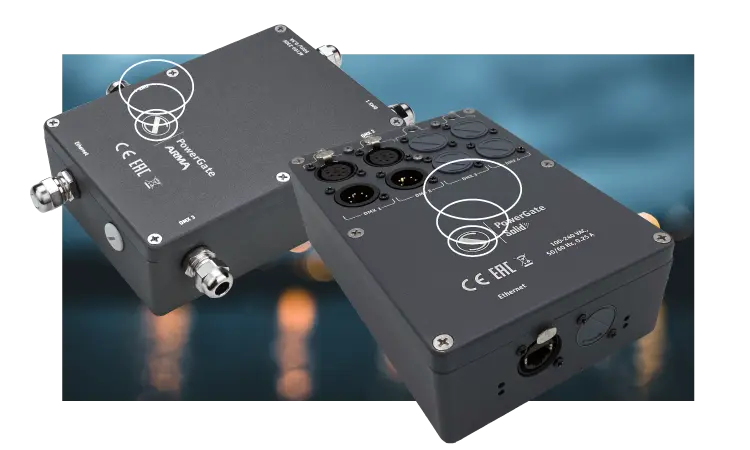Table of Contents
In 2010, a client from Dubai approached our company with a request to reconstruct a large palace featuring an expansive marble floor crafted from highly valuable marble. During the design phase, standard white light fixtures were integrated into the floor. Upon completion, when the project was presented to the client, they revealed their preference for colored light fixtures controlled by a unified system. No control cables, apart from power lines, had been installed in the floor, and the cable channels were already sealed. Dismantling the extremely valuable marble floor was not a feasible option due to its high cost. Our company proposed developing a device capable of transmitting up to four DMX512 universes over a 250 V power line. The product was designed and delivered in an exceptionally short timeframe, successfully resolving the issue and satisfying the client.
The PowerGate device was engineered using an adapted version of HomePlug 1.0 technology tailored for DMX512 transmission. HomePlug is a Powerline Communication (PLC) technology that transmits data over existing electrical wiring. It was developed in the early 2000s under the HomePlug Powerline Alliance, established in 2000. The initial HomePlug 1.0 standard, released in 2001, supported data rates up to 14 Mbps. In 2005, HomePlug AV was introduced, offering speeds up to 200 Mbps for multimedia applications. In 2010, HomePlug AV2 emerged with speeds up to 1 Gbps and MIMO support. Although the alliance ceased operations in 2022, HomePlug devices remain in use.
HomePlug technology leverages standard electrical wiring (220/110 V) as a medium for digital data transmission, eliminating the need for additional control cables. When a HomePlug adapter is connected to the electrical network, it performs multiple functions. It receives a digital signal (e.g., from a router) and converts it into a high-frequency modulated signal compatible with the power grid. This modulation uses Orthogonal Frequency-Division Multiplexing (OFDM), where data is divided into multiple narrow subcarrier frequencies transmitted in parallel. This method ensures reliable signal transmission despite electrical noise or electromagnetic interference.
The modulated signal travels through the same electrical wires used for power delivery. Another HomePlug adapter, connected to a different outlet within the same network, receives and decodes the signal, extracting the original digital data for output. To ensure security, adapters employ end-to-end AES-128 encryption, preventing data interception. Each adapter set is assigned a unique identifier.
The system’s performance depends on the quality of the electrical wiring. Interference from devices such as chargers or power supplies, or the use of different electrical phases in multi-phase systems, can disrupt signal transmission.
HomePlug transforms any electrical outlet into a potential data source without requiring dedicated control cabling. In PowerGate devices, this technology is optimized for DMX512 transmission, where even minimal delays could desynchronize lighting fixtures. To prevent this, PowerGate incorporates an additional synchronization system.
PowerGate devices comprise a DMX512 transceiver, a specialized PLC modem based on a modified HomePlug technology optimized for stage lighting, protective systems, and a power module.
PowerGate is available in two variants: the Solid series for indoor use and the Arma series for outdoor applications.
Both are offered in configurations supporting one or four DMX512 universes.
is designed for indoor environments but can operate in sheltered outdoor areas at temperatures from -5°C to 85°C (23°F to 185°F). It is encased in a robust cast aluminum alloy housing with walls up to 3 mm thick, ensuring durability during operation. A specialized cooling system dissipates heat to the housing, which lacks ventilation openings to prevent dust and foreign object ingress, significantly enhancing reliability.
The device features a built-in power supply that operates at voltages up to 305 V and provides full galvanic isolation for all ports. This protects the device from damage if a phase voltage appears on DMX512 control lines and improves port compatibility with diverse equipment.
is built for year-round outdoor use without shelter, boasting an IP65 protection rating and operating in an industrial temperature range of -40°C to +85°C (-40°F to 185°F), enabling global deployment. Power and control lines are connected via nickel-plated metal cable glands with an IP67 protection rating.
PowerGate devices support flexible configurations, operating in a one-transmitter-to-one-receiver mode or a one-transmitter-to-up-to-256-receivers mode. Up to 256 such groups can be created, allowing for virtually limitless network setups.
PowerGate was developed as a critical solution for scenarios where radio-based DMX512 transmission is prohibited or impractical.
PowerGate is widely used in architectural monuments, temples, cathedrals, and embankments where power cables were installed decades ago, and adding control lines is no longer possible. It is also employed in new constructions where control cables were omitted during building. PowerGate is particularly popular for controlling in-ground lighting fixtures.
In historic theaters, PowerGate facilitates control signal transmission from dimmers to the auditorium. These venues often have extensive power lines tied to outdated dimmer-based lighting control systems, but laying new control cables is either impossible or highly labor-intensive.
PowerGate serves as an alternative to radio-based solutions in environments where radio use is restricted. Large venues increasingly face radio spectrum congestion or employ jamming systems, particularly during events involving high-profile individuals. In countries where radio transmission is prohibited, PowerGate provides the only viable method for delivering control signals.

